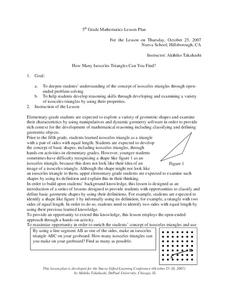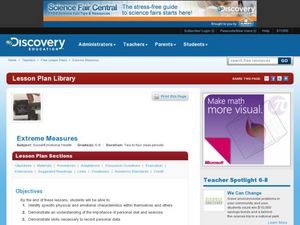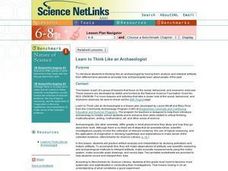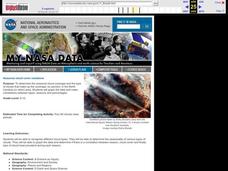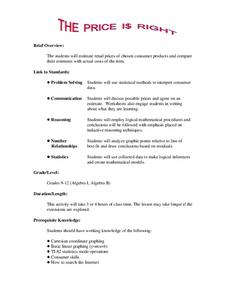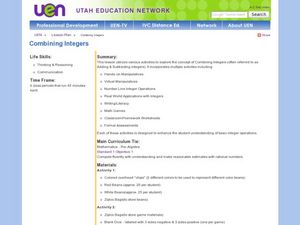Curated OER
Mobius Strips
Students discuss the scientific method and construct their own Mobius Strips. They examine their Mobius Strip, and write observations and a hypothesis on how many strips of paper they have when they cut the strip in half length-wise.
Curated OER
Analysis of Atmospheric Conditions for a High Mountain Retreat
Students examine the relationship between altitude, atmospheric pressure, temperature and humidity at a particular location. They practice science and math in real world applications. They write reports detailing their scientific...
Curated OER
High Mountain Retreat
Learners explore and analyze atmospheric conditions for a high mountain retreat. They examine the relationship between altitude, atmospheric pressure, temperature and humidity at a particular location. In addition, they write reports...
Curated OER
How many isosceles Triangles Can You Find?
Fifth graders solve problems while examining a variety of isosceles triangles. In this isosceles triangle lesson, 5th graders examine shapes to find their characteristics. Students pay particular attention to the characteristics of...
Curated OER
Extreme Measures
Students take a closer look at their personal diets. In this personal health lesson, students watch "Extreme Measures," keep personal health journals, and discuss the obsession with perfect bodies. The instructor may also invite...
Curated OER
Hurricane Frequency and Intensity
Students examine hurricanes. In this web-based meteorology lesson, students study the relationship between ocean temperature and hurricane intensity. They differentiate between intensity and frequency of hurricanes.
Curated OER
Who Plays What?
Ninth graders divide in pairs 3 cards with the words possible, impossible and certain on them. Ask questions of the class and get the students to hold up the word that describes the event (for example) Tomorrow it will snow. You have...
Curated OER
Leaarn to Think Like an Archaeologist
Students examine how to act as archaeologists by examining artifacts. The inquiry is meant to teach learners about analysis of ancient civilizations and scientific finds. Fossil evidence is also covered to make connection to the...
Curated OER
Reducing Volcanic Hazards to People and Property
Students examine and research major hazards to humans located in the area of volcanoes and write a general summary. Students must choose a volcano and determine what actions might be taken to reduce risks to a population. Summaries are...
Curated OER
Batter Up
Students use a variety of strategies to figure out the cost of baseball tickets. They use a combination chart, notebook notation, etc. to find the cost of their family to attend a Cardinal's game in St. Louis.
Curated OER
Daily Weather Calendar
Third graders use the internet to record the daily weather conditions. Using symbols, they take the information they gathered and create an easy to read chart. They share their charts with the class to end the activity.
Curated OER
Sets and the Venn Diagram
Students review number sets and complete a Venn Diagram for number sets. In this number sets activity, students review integers, whole numbers, and elements. Students use computers to create a Venn Diagram for number sets. Students...
Curated OER
Venn Diagram and Shape Sorting Lesson Plan
Young scholars use Venn diagrams to represent classifications of shapes and to use counting arguments to find the number of objects in a given set.
Curated OER
Carbon Footprint Estimator
Students discover what a Carbon Footprint represents. In this sustainable lifestyle lesson plan, students determine their Carbon Footprint as an individual and as a class. Students use a the Internet to calculate how many earths it would...
Curated OER
Fahrenheit vs Celsius
Learners construct a thermometer and convert Fahrenheit temperature into Celsius temperature. In small groups, they construct a thermometer, write a paragraph describing how to make a thermometer, and convert temperatures.
Curated OER
Seasonal Cloud Cover Variations
High schoolers recognize different cloud types. They determine the seaonality of various types of clouds. They graph the data and determine if a correlation exists between season, cloud cover and type of clouds most prevalent during each...
Curated OER
Visual Opacity
Students discover the difference between transparent, translucent and opaque. They use those descriptions to classify clouds. They create a presentation in which they show the different types of clouds with their descriptions.
Curated OER
Identifying Clouds
Students work in groups to research and prepare a report on cloud types. They present their findings to the class and take a group quiz competing for points. Students go outside and determine which type of clouds are visible on that day.
Curated OER
We the People. . .
Students explore the United States Constitution. In this government lesson, students write newspaper editorials that reflect their opinions about Amendments.
Curated OER
The Price Is Right
Young scholars create a list of products with estimated prices. In this algebra lesson, students learn to write equations using variables. They match their created list with that of actual products and compare their prices,
Curated OER
Rolling Marbles
Pupils develop and use problem solving strategies to mathematically solve a word problem involving marbles. They solve the first part of the problem together as a class, and in small groups solve and write a solution for the problem...
Curated OER
Combining Integers
Seventh graders explore the concept of adding and subtracting integers. In this adding and subtracting integers lesson, 7th graders use white and red beans to demonstrate adding and subtracting integers. Students play an on-line game...
Curated OER
The Strength of the Muscular System
Seventh graders investigate the strength of the muscular system. They explore voluntary and involuntary muscle movement and discuss the types of muscles: cardiac or heart, skeletal, and smooth. They visit stations to answer questions...
Curated OER
The Miracle Fish: Learning to Design an Experiment
Students develop procedures to explore the behavior of fish. In this scientific experiment lesson plan students from a hypothesis, write a question, identify different variables and controls in their experiment.





